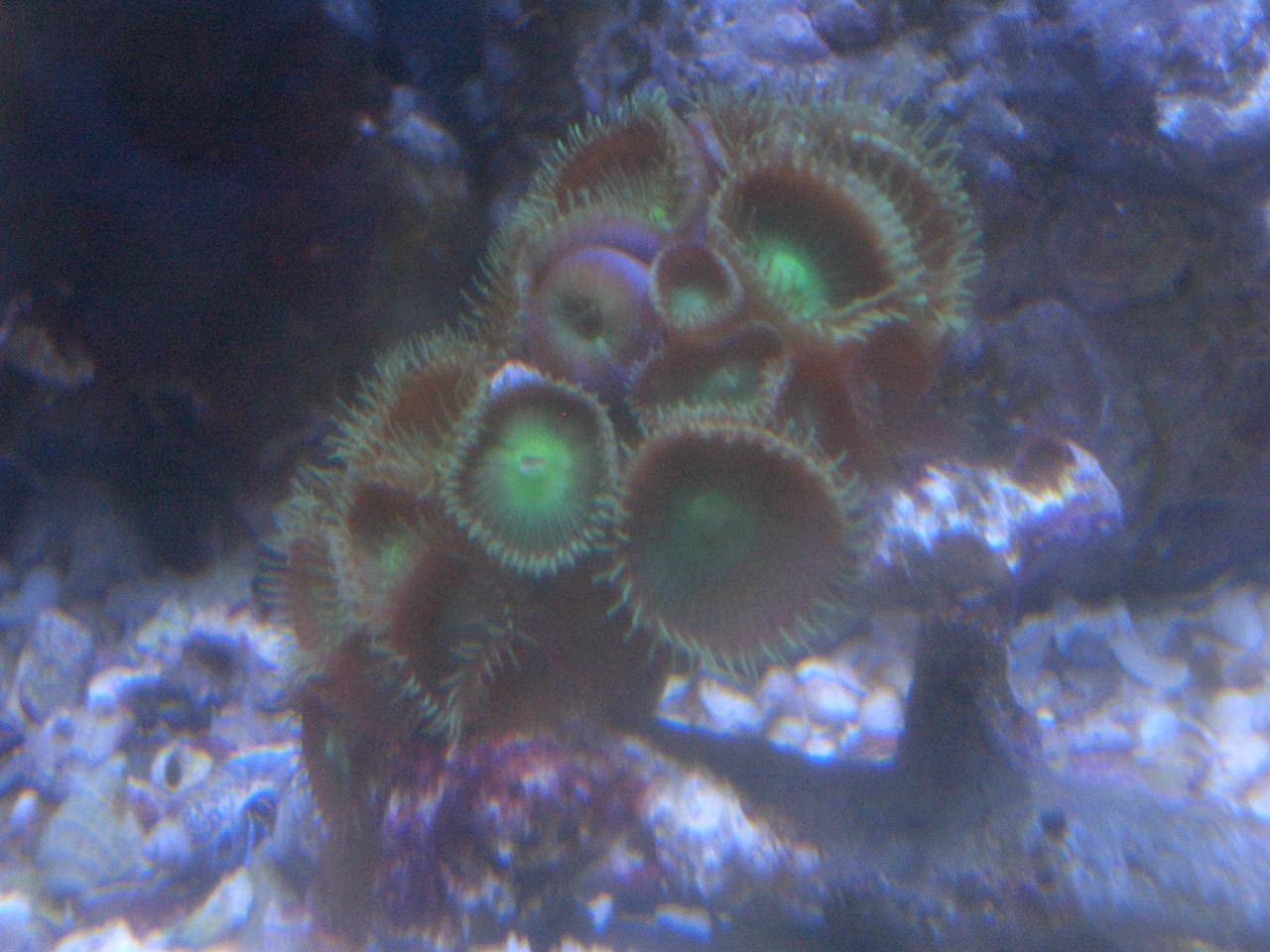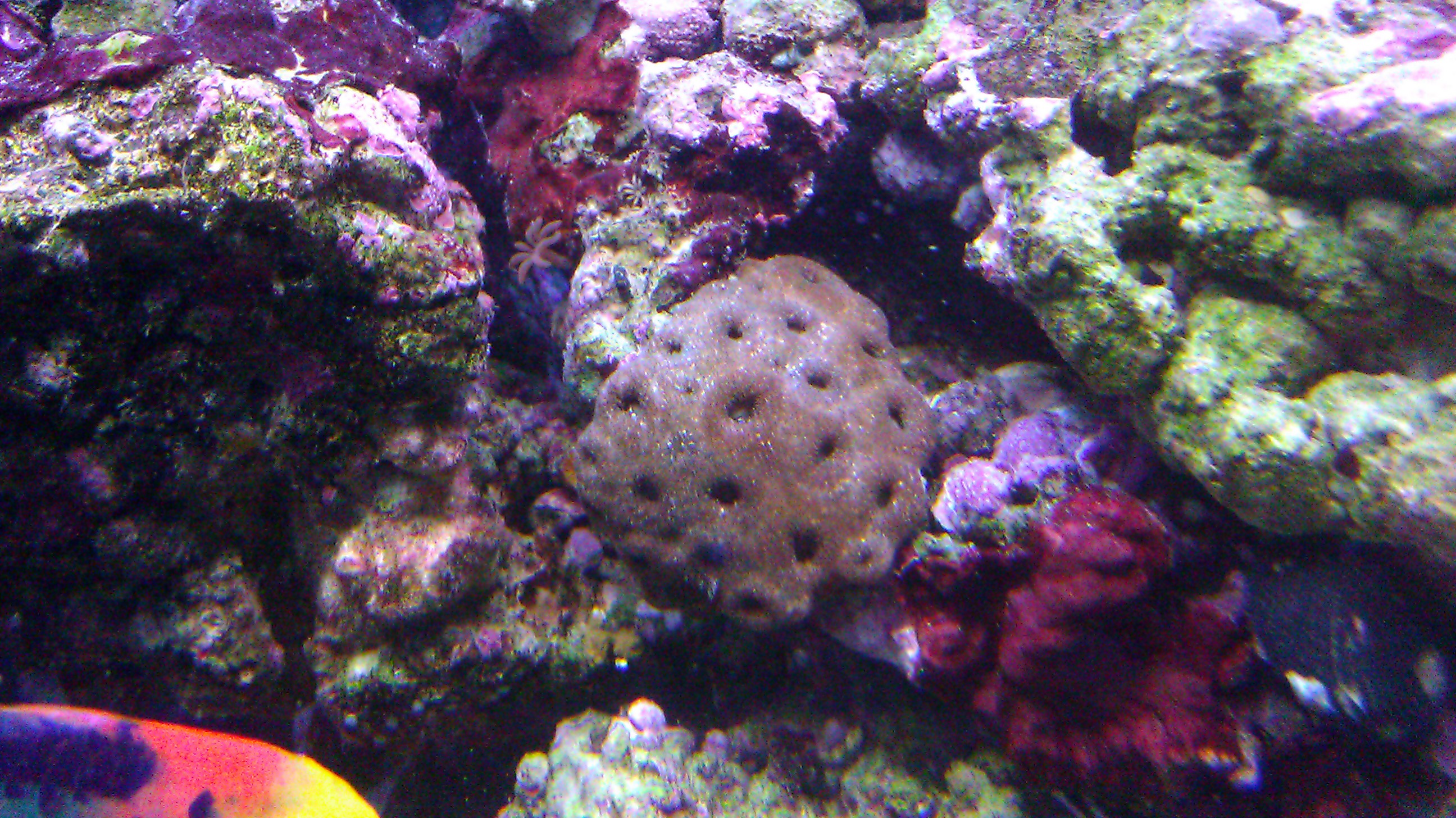zoos?
- Thread starter anti
- Start date
tangs rule
Active Member
Protopalythoa sp. (large button polyps)
I have 2 types of them (one set has polyps 1/4" diameter - the other larger at 3/4", and both are very hardy, almost hard to kill - but also rather aggressive - so keep all other corals 2-3 inches away. Mine have very bright green centers, but do not seem to reproduce very fast - so I keep them....some Protopalythoa sp. can reproduce rapidly in a reef system and damage/overtake other species...
It'd be best to research more your own as you can - what you have before they become a problem - also see "palytoxin" as all of the Palythoa genus produce this toxin - and if you attempt to remove these polyps - use thick rubber gloves & goggels - and for Gods sake - don't damage them/scrape them in a tank with fish in it - a mass release of this toxin in your water could wipe out all your fishes! ! !
Submit yours to some light for a month or 2 and see if the centers take on some green and look for rapid growth by division....usually the more "bland or tan" they are - the more rapid growing. Most specific species of this type are still unclassified.
Here's mine (3/4" dia type) [I think is Protopalythoa mutuki]:

I have 2 types of them (one set has polyps 1/4" diameter - the other larger at 3/4", and both are very hardy, almost hard to kill - but also rather aggressive - so keep all other corals 2-3 inches away. Mine have very bright green centers, but do not seem to reproduce very fast - so I keep them....some Protopalythoa sp. can reproduce rapidly in a reef system and damage/overtake other species...
It'd be best to research more your own as you can - what you have before they become a problem - also see "palytoxin" as all of the Palythoa genus produce this toxin - and if you attempt to remove these polyps - use thick rubber gloves & goggels - and for Gods sake - don't damage them/scrape them in a tank with fish in it - a mass release of this toxin in your water could wipe out all your fishes! ! !
Submit yours to some light for a month or 2 and see if the centers take on some green and look for rapid growth by division....usually the more "bland or tan" they are - the more rapid growing. Most specific species of this type are still unclassified.
Here's mine (3/4" dia type) [I think is Protopalythoa mutuki]:
tangs rule
Active Member
Ahhhhh - that's a bit different - more of a "mat" style that can be seen when polyps retract into it - likely Palythoa caesia if it came from the pacific or Palythoa caribaeorum if it came from the Atlantic waters - either way it's very fast growing and very aggressive - I'd get rid of it with cautions mentioned -
[hr]
After further research, I'd be very careful with this type of polyp. Palytoxin (if produced / present) in these and similar types is incredibly toxic - requiring only nanograms to be fatal if introduced to your system. A nanogram is 1 billionth of a gram! Handle with extreme care!
[hr]
After further research, I'd be very careful with this type of polyp. Palytoxin (if produced / present) in these and similar types is incredibly toxic - requiring only nanograms to be fatal if introduced to your system. A nanogram is 1 billionth of a gram! Handle with extreme care!
tangs rule
Active Member
FWIW:
Usually Palythoa absorb sand/substarte material in their mat tissue and/or stems - Zoas do not......both my green slow growing palythoas show lots of aragonite&sand imbedded in them when the polyps retract. Notice all the substrate material imbedded in your 2nd pic of the closed polyp mat?
Usually Palythoa absorb sand/substarte material in their mat tissue and/or stems - Zoas do not......both my green slow growing palythoas show lots of aragonite&sand imbedded in them when the polyps retract. Notice all the substrate material imbedded in your 2nd pic of the closed polyp mat?
tangs rule
Active Member
Quote:
Originally Posted by anti http:///forum/thread/383670/zoos#post_3357426
You mean to help ID?
Yup - unless your rock covered with zoas falls into the substrate and sits there long enough for them to retract and absorb "some" then they might look like they have sand/aragonite imbedded, but even then, moat zoas will expel it over time.......palythoa actually use it and if cut 1 open, you'll find it permanantly imbedded inside, and some researchers think palythoa can actually "make crystals of aragonite" using some form of light-induced biological mineralization.
Originally Posted by anti http:///forum/thread/383670/zoos#post_3357426
You mean to help ID?
Yup - unless your rock covered with zoas falls into the substrate and sits there long enough for them to retract and absorb "some" then they might look like they have sand/aragonite imbedded, but even then, moat zoas will expel it over time.......palythoa actually use it and if cut 1 open, you'll find it permanantly imbedded inside, and some researchers think palythoa can actually "make crystals of aragonite" using some form of light-induced biological mineralization.
tangs rule
Active Member
Just remember that palytoxin is very posionus and if injested or squirted into eyes/mouth can cause severe reactions. Breaks in the skin are problem areas too where it can enter your system.....Both Palythoa sp. and Protopalythoa sp. produce much more of the toxin than regular zoanthids in their mucus/slime and they also produce more slime/mucus. I have gotten sick from it before due to not washing my hands REALLY well & scrubbing with soap after handling my large button polyps. Numbness & metallic taste in the mouth are signs of injestion of TINY ammounts of it. (I've experienced these)
Lager doses (still minute) result in:
Typical symptoms of palytoxin poisoning are angina-like chest pains, asthma-like breathing difficulties, tachycardia, unstable blood pressure, hemolysis (destruction of red blood cells), and an electrocardiogram showing an exaggerated T wave. The onset of symptoms is rapid, and death usually follows just minutes after. (from (From wiki)
So handle with tongs/gloves & wash up well after! ! !
Lager doses (still minute) result in:
Typical symptoms of palytoxin poisoning are angina-like chest pains, asthma-like breathing difficulties, tachycardia, unstable blood pressure, hemolysis (destruction of red blood cells), and an electrocardiogram showing an exaggerated T wave. The onset of symptoms is rapid, and death usually follows just minutes after. (from (From wiki)
So handle with tongs/gloves & wash up well after! ! !


